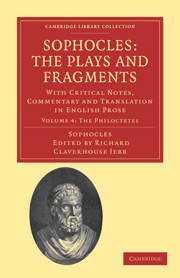ANCIENT ARGUMENTS TO THE PLAY; DRAMATIS PERSONAE; STRUCTURE
Published online by Cambridge University Press: 05 October 2010
Summary
ΦΙ∧ΟΚΤΗΤΟϒ ϒΠΟΘΕ∑Ι∑.
Χρύσης ʾΑθηνᾶς βωμὸν ἐπικεχωσμένον,
ἐφʾ οὗπερ ʾΑχαιοῖς χρησθὲν ἦν θῦσαι, μόνος
Ποίαντος ᾒδει παῖς ποθʾ ʿHgr;ρακλεῖ ξυνών.
ζητῶν δὲ τοῦτον νανβάτῃ δεῖξαι στόλῳ,
πληγεὶς ὑπʾ ἔχεως, ἐλίπετʾ ἐν ∧ήμνῳ νοσῶν.
῞Ελενος δʾ ʾΑχαῖος εἶφʾ ἁλώσεσθʾ ῞Ιλιον
τοῖς ʾΗρακλέους τόξοισι παιδί τʾ ʾΑχιλλέως.
τὰ τόξʾ ὑπῆρχε παρὰ Φιλοκτήτῃ μόνῳʾ.
πεμφθεὶς δʾ ʾΟδυσσεὺς ἀμφοτέρους συνήγαγεν.
This metrical Argument, with the heading Φιλοκτήτου υ, stands in L (p. 79 b) immediately after the ἆθλοι ʿΗρακλέους, twelve hexameters which are placed at the end of the Trachiniae. Then comes the prose Argument, with the heading ἄλλως, followed by τὰ τοῦ δράματος πρόσωπα. The metrical Argument was first printed in the ed. of Sophocles by Turnebus (Paris, 1553), who found it in the Paris 15th century ms., T (cod. 2711). It is absent from the earlier editions (those of Aldus, Junta, and Camerarius), since the mss. on which they were chiefly based did not contain it. (Cp. O. C. p. liv.)—The workmanship of these iambics is decidedly worse (and presumably much later) than that of the metrical Argument to the Oedipus Tyrannus. In v. 2 an anapaest holds the second, and in v. 9, the fourth place; while in v. 6 ἁλώσεσθʾ ῞Ιλιον combines an impossible elision with an impossible spondee. In v. 5 ἐλίπετʾ has the sense of ἐλείφθη, a Homeric use of the aor. midd. which is unknown to later classical Greek.
- Type
- Chapter
- Information
- Sophocles: The Plays and FragmentsWith Critical Notes, Commentary and Translation in English Prose, pp. 1 - 5Publisher: Cambridge University PressPrint publication year: 2010First published in: 1890



